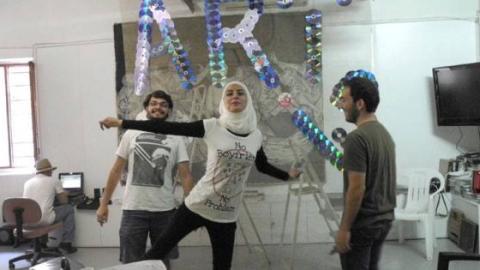“We want to bring hope to civilians caught between two fires. People here, more than anywhere, need to know that they are not alone, and this is why we chose Aleppo.”
These are the words of a group of students of fine arts and other disciplines who met while taking art courses and workshops at an Aleppo studio called “Le Pont” (The Bridge). The workshops became places for dialogue and interaction on issues related to Syria, and have given birth to a project called Art is Peace, that seeks to bring art to the old city of Aleppo.
“We wanted to display the art in the square of the Aleppo University, so that more people could see it, but the student´s union denied us permission,” Mohammad, one of the artists, said to Syria Untold. “So we decided to do it in historic archaeological site Jadida, which is also quite a centric spot.”
Jadida is actually a hot spot. The artists work at about 20 metres from the line of fire and they have suffered the regime´s shelling before. The sight of a group of young people drawing in the streets came as a shock to the neighbors of this area, which has been marginalized and unattended since it became war zone. “They are getting used to us, though,” Mohammad admitted. “They now invite us to see their houses, beautiful traditional houses typical of old Aleppo, whose owners have not been able to invite anyone to for a long time.”

“The more war you bring upon us, the more art we will bring upon you,” is one of the mottos of this group, as highlighted on their Facebook page. “Keep your religion to yourself, and share your art with everyone” is another of their slogans. They define themselves as secular and believe that religion should be a matter between each individual and God, while art should be publicly shared and enjoyed by everyone.
Most of their paintings reflect the details of everyday life in the old city, capturing its details, from a fresh-baked pie or a drawing on the wall to the archeological lines marked all over the ancient streets. They seek to register the color and diversity of their country on their improvised canvases, where art and life defy death and destruction.
The artists use things they find around them to paint and make their creations, including old fabric and CDs. They give their art to the people who invite them to their houses so that they hang it on their walls as a symbol of hope and resistance.
“I remember this little girl who came and asked us: What are you doing this for?” Mohammad recalled. “‘For you, I told her, and she gave me this huge smile, and asked me to take her picture with her friends under the Art is Peace banner.”
The group is now working on a short movie to show how the life of a group of young people has changed since the beginning of the uprising, with a special focus on children.
Watch how the team works on this video, taken from the Art is Peace facebook page:
https://www.youtube.com/watch?v=Ae7kA0A2G8w



